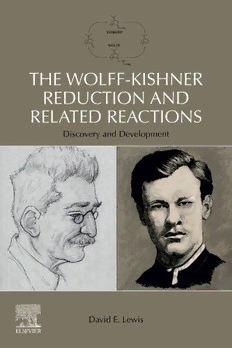
The Wolff-Kishner Reduction and Related Reactions: Discovery and Development PDF
Preview The Wolff-Kishner Reduction and Related Reactions: Discovery and Development
The Wolff-Kishner Reduction and Related Reactions The Wolff-Kishner Reduction and Related Reactions Discovery and Development David E. Lewis Department ofChemistry University of Wisconsin-Eau Claire Eau Claire, WI, United States Elsevier Radarweg29,POBox211,1000AEAmsterdam,Netherlands TheBoulevard,LangfordLane,Kidlington,OxfordOX51GB,UnitedKingdom 50HampshireStreet,5thFloor,Cambridge,MA02139,UnitedStates ©2019ElsevierInc.Allrightsreserved. Nopartofthispublicationmaybereproducedortransmittedinanyformorbyanymeans, electronicormechanical,includingphotocopying,recording,oranyinformationstorageand retrievalsystem,withoutpermissioninwritingfromthepublisher.Detailsonhowtoseek permission,furtherinformationaboutthePublisher’spermissionspoliciesandourarrangements withorganizationssuchastheCopyrightClearanceCenterandtheCopyrightLicensingAgency, canbefoundatourwebsite:www.elsevier.com/permissions. Thisbookandtheindividualcontributionscontainedinitareprotectedundercopyrightbythe Publisher(otherthanasmaybenotedherein). Notices Knowledgeandbestpracticeinthisfieldareconstantlychanging.Asnewresearchandexperience broadenourunderstanding,changesinresearchmethods,professionalpractices,ormedical treatmentmaybecomenecessary. Practitionersandresearchersmustalwaysrelyontheirownexperienceandknowledgeinevaluating andusinganyinformation,methods,compounds,orexperimentsdescribedherein.Inusingsuch informationormethodstheyshouldbemindfuloftheirownsafetyandthesafetyofothers, includingpartiesforwhomtheyhaveaprofessionalresponsibility. Tothefullestextentofthelaw,neitherthePublishernortheauthors,contributors,oreditors, assumeanyliabilityforanyinjuryand/ordamagetopersonsorpropertyasamatterofproducts liability,negligenceorotherwise,orfromanyuseoroperationofanymethods,products, instructions,orideascontainedinthematerialherein. LibraryofCongressCataloging-in-PublicationData AcatalogrecordforthisbookisavailablefromtheLibraryofCongress BritishLibraryCataloguing-in-PublicationData AcataloguerecordforthisbookisavailablefromtheBritishLibrary ISBN:978-0-12-815727-5 ForinformationonallElsevierpublications visitourwebsiteathttps://www.elsevier.com/books-and-journals Publisher:SusanDennis AcquisitionEditor:EmilyM.McCloskey EditorialProjectManager:SaraPainaVilla ProductionProjectManager:VijayarajPurushothaman CoverDesigner:MilesHitchen TypesetbySPiGlobal,India Dedication This book is dedicated to my wife, Deborah, whose unstinting support has now endured over four decades. Preface TheWolff-Kishnerreduction,namedforRussianchemistNikolaiMatveevich Kizhner (1867–1935) and German chemist Ludwig Wolff (1856–1919), has beenamajorsyntheticmethodforoveracentury.Theconditionsforthereac- tionasoriginallyreportedareratherharsh,somuchefforthasbeenexpendedin thecenturysinceitsdiscoveryinanefforttomoderatethereactionconditions. Asaconsequence,theWolff-Kishnerreductionhasbeenmodifiedmanytimes overthepastcentury,witheachmodificationseekingtomoderatethereaction conditionsortoimproveitsperformanceinparticularlyhinderedenvironments. Ithasbeenchosenastheinauguralvolumeintheseries,OrganicNameReac- tions. Biography,Discovery andDevelopment. In 1911, Kizhner, Professor of Organic Chemistry at the Imperial Tomsk Technological Institute,inSiberia,reportedhisdiscovery thatthehydrazones of aldehydes and ketones reacted with base at high temperature to give the hydrocarbon and nitrogen gas. Kizhner published his report in the ZhurnalRusskogoFiziko-KhimicheskogoObshchestva[JournaloftheRussian Physical-Chemical Society], the top chemical journal in Russia. As a con- sequence, the language of publication was Russian, which meant that it was not noted inthe westbecause few western chemists could read Russian. EighteenmonthslaterWolff,workingattheChemicalInstituteofJenaUni- versity,publishedavariantofthesamereactioninJustusLiebigsAnnalender Chemie.Wolff’svariantinvolvedthebase-promoteddecompositionofasemi- carbazone. By being published in the Annalen, the leading journal in organic chemistryatthetime,andthusbeingpublishedinGerman, thedominantlan- guage of organic chemistry at the time, Wolff’s paper attracted widespread attention. The reaction became known as the Wolff reduction until January 10,1913,whenWolffacknowledgedKizhner’spriorityforthediscovery.From that time forward, the reaction has borne the names ofboth chemists. Inthisvolume,thediscoveryanddevelopmentoftheWolff-Kishnerreduc- tion are explored. In Chapter 1, the chemists responsible for its discovery are introduced, and other reactions that carry their names are highlighted. This givesthe reader a rounded biography of each, paying respect tothe humanity inchemistry—Wolff andKizhnerwere real individuals with human strengths andweaknesses.Withthemajorplayersintroducedtothereader,thenarrative inChapter2turnstothediscoveryofthereaction,anditsearliestdisclosuresto thechemicalcommunity.InChapter2,thequestionofpriorityanditsresolution xi xii Preface isalsoexplored.Chapter3focusesontheearlystudiesofthereactionuptothe endofWorldWarII.InthisChapter,themechanisticstudiesofthereactionare discussedalongwiththescopeandlimitationsofthereaction.InChapter4,one ofthe most important modifications of the reaction, the Huang Minlon modi- fication,isdiscussedalongwiththebiographyoftheChinesechemistwhodis- covered it, Huang Ming-Long of the Academia Sinica. Chapter 5 focuses on versions of the reaction developed since the Huang-Minlon modification, including derivative reactions based on sulfonylhydrazones: the Caglioti and Hutchins reductions, the Shapiro reaction to give vinyllithiums and the related Bamford-Stevens reaction. Chapter 6, the various versions of the Kishner reduction-elimination discussed. The reactions covered in Chapter 6 include the Wharton and aza-Wharton reactions to generate allylic alcohols from α-epoxyketones and allylic amines from 2-acylaziridines, and the Eschenmoser-Tanabe fragmentation of α-epoxyketones to alkynyl ketones. ThefinalchapterofthebookexplorestheuseoftheWolff-Kishnerreduction initsmany variants inthe synthesisof complex molecules. Acknowledgments Itismypleasuretoacknowledgethehelpandhospitalityofthemuseumsand facultyofKazanFederalUniversityandofTomskPolytechnicUniversityfor providingaccesstoimagesandartifactspertinenttothisbook.AtTomskPoly- technicUniversity,thehospitalityofProfessorsM.YusubovandV.Filimonov, whofacilitatedmyvisittoKizhner’slaboratoryandlibrary.AtKazanFederal University, I am indebted to Ms. G. Mel’nikova, Director of the Butlerov Museum of the Kazan Chemical School, Professors I. Antipin and V. Galkin, and Academician A. Konovalov for their hospitality and help over several years.IamalsoindebtedtoDr.V.ShtyrlinandProfessorA.Zakharovformany helpfuldiscussions.Mr.JohnMcCrackin,InterlibraryLoanandUWResource Sharing Coordinator at the McIntyre Library of the University of Wisconsin- EauClaire,hasbeenanespeciallyvaluablecolleaguewithanuncannyability to locate even the mostobscurearticles and books. xiii Chapter 1 The discoverers of the reaction In 1911, Russian chemist Nikolai Matveevich Kizhnera (Кижнер, Николай Матвеевич, 1867–1935, Fig. 1.1), of the Tomsk Technological Institute (nowTomskPolytechnicUniversity)inSiberia,publishedthefirst(1)ofsev- eral papers (2) in which he described the formation of hydrazones and their decomposition by base at high temperature to give hydrocarbons. Eighteen months later, German chemist Ludwig Wolff (1857–1919, Fig. 1.1), of Jena University, publishedhis version of the same reaction (3). Nikolai Matveevich Kizhner: A truly eventful life (4,5) Nikolai Matveevich Kizhner was born in Moscow on December 9, 1867. His earlylifeisactuallyshroudedinmystery,sowehavelittlebutconjectureuntil hegraduatedfromtheFirstMoscowGymnasiumin1886.Yushkovskii(4(d)) reportsthattherearetwodifferentviewsabouthisfamilyorigins:somesources holdthathewasbornintoafamilyofMilitaryMedicalAssistants,similartothe “medics” in a modern army. Other sources assert that his father was a Court Counselor—notamemberoftheRoyalCourtorthenobility,butapublicser- vant fromthe middle class with responsibilities for advisingthe government. KizhnergraduatedfromtheFirstMoscowGymnasiumin1886,andimme- diatelyenteredMoscowUniversityasastudentinthe FacultyofNaturalSci- ences.Kizhnerwasundeterminedasfarashisfuturewentwhenhefirstentered theUniversity.ButthenhemettwoProfessorswhohadaprofoundinfluenceon his future (Fig. 1.2): Vladimir Fyodorovich Luginin (Лугинин, Владимир Фёдорович, 1834–1911), who taught analytical techniques, and Vladimir a. TransliterationofRussiannamesfromtheCyrillicintotheRomanalphabetisaperennialprob- lemforhistoriansofchemistry.Throughoutthisbook,theBGN/PCGNRomanizationsystemfor RussianisusedasthemostintuitiveforEnglishspeakers.Generally,thevowels“е”isrendered as“ye”whentheinitialletterofaword;thevowel“я”isrenderedas“ya”(notia).Theletter “й”isrenderedas“i,”ratherthan“y,”sothediphthong,“ий”isrenderedas“ii,”andthevowel “ы”as“y.”Thesoftsign,“ь,”isrenderedas’,andthehardsign,“ъ,”as”.Dependingonthesource, Kizhner’snamehasbeentransliteratedasKishner,KijnerandKizˇner;thetransliteration,“Kizhner,” isusedinthebodyofthetexthere,butinwesternjournalreferences,theoriginaltransliterationused bythejournalitselfisretained. TheWolff-KishnerReductionandRelatedReactions.https://doi.org/10.1016/B978-0-12-815727-5.00001-6 ©2019ElsevierInc.Allrightsreserved. 1 2 TheWolff-Kishnerreductionandrelatedreactions FIG.1.1 Theprincipalsofthisbook:(left)NikolaiMatveevichKizhner(Кижнер,Николай Матвеевич)1867–1935,and(right)LudwigWolff(1854–1919).(ImageofKizhner©2017Mat- thewBergs.Allrightsreserved.ImageofWolff©2017SierraLomo.Allrightsreserved.Images reproducedbypermissionoftheartists.) FIG. 1.2 Kizhner’s mentors, Luginin (1834–1911) and Markovnikov (1838–1904). (Public domain images courtesy of Lomonosov Moscow State University (Luginin) and the Butlerov MuseumoftheKazanChemistrySchool,KazanFederalUniversity(Markovnikov).)
